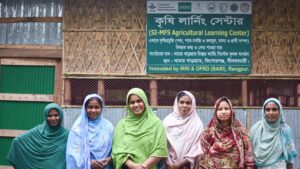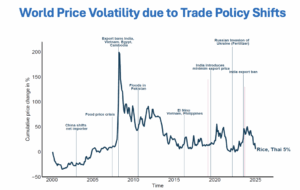A reluctant rock star scientist talks about making science and scientists approachable, his own creative process, and the GMO debate. He also has good advice for young researchers.
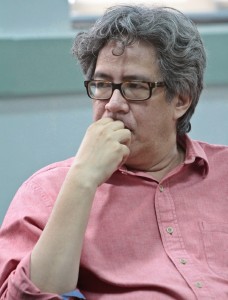
Michael D. Purugganan is the Dorothy Schiff Professor of Genomics and the Silver Professor of Biology at New York University (NYU). He heads the Purugganan Laboratory at the Center for Genomics and Systems Biology at NYU that focuses on evolutionary, ecological and functional genomics of plants.
Among his current research activities include the Environmental Gene Regulatory Interaction Network project to characterize gene regulatory networks involved in the rice stress response and the multiple active QTL mapping projects to identify genes controlling variability in salt tolerance among rice varieties.
There are scientists and then there are rock star scientists. What’s the difference? Unlike their counterparts in the entertainment industry, rock star scientists aren’t surrounded by an entourage. They do not make dramatic entrances nor do they strut around the lab wearing flashy gowns. They are actually regular scientists but with a little something extra. Writer Matt Hickman described it best:
It’s all about the charisma, a willingness to communicate and, at times, stir up a bit of controversy… challenging convention and getting people to wake up and acknowledge the world around them, to think.
Michael Purugganan, Dorothy Schiff Professor of Genomics and Professor of Biology at New York University and a collaborator with the International Rice Research Institute (IRRI), certainly fits the description. In a recent interview during one of his stops at IRRI to monitor an ongoing project on the systems genomics of adaptation to rice drought stress, the Filipino-American biologist and former journalist covered his strategy for a successful career in research, the importance of making the general public excited about science, paying it forward, and the touchy subject of genetically modified crops.
What is the secret of being a rock star scientist?
I don’t like the term “rock star scientist.” Let’s just say I am happy people recognize our work and we’re able to make contributions to our fields. That took a lot of hard work and some bit of luck. But I think a lot of hard work more than anything else
What is your advice to young scientists who want to have the same kind of success?
The one thing I would advise young scientists is to keep on asking questions and keep on thinking of projects. I tell people I am constantly thinking of new ideas and that maybe only one in a hundred will survive. But if I weren’t constantly thinking of new questions I wouldn’t find those gems of ideas that I eventually work on.
If I think of a hundred ideas, probably 80 of them would not survive for more than 5 seconds in my mind. I just think of them as interesting. Maybe about 20 of those I will actually be interested enough to go on and read up a little bit on. Then I decide if they’re interesting or not. Of that 20, maybe 5 would be interesting enough to really think about more deeply. Maybe one will actually bear fruit in terms of I really want to do this project. But I have to think of those 100 questions first before I could get to that one. So to constantly come up with ideas is important even though many of them I am going to discard. But, at least, you are always thinking.
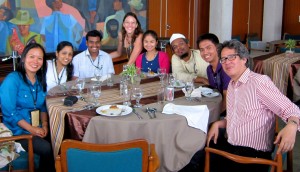
Describe your creative process in coming up with those ideas.
I make connections in very different areas of work. That’s the other advice I would give to young scientists. Reach out beyond the area you specialize in working and explore very different areas of knowledge. I would read a paper in another field, for example, and think, hmmm…, that’s interesting. I wonder if I can do it in rice. If you can have a very open mind and see connections between what seems to be very different areas of research, that is when very interesting things happen.
For example, I have interacted with archaeologists. We have done projects together involving my molecular work based on reading up on paleontology and archaeology. I would have not done that if I wasn’t open to talking to archaeologists and working on rice data and put things together. It’s the ability to look at very different scientific areas and looking at the commonalities that you can use in your work.
You head the Purugganan Laboratory for plant evolutionary genomics. How did you manage to get your own laboratory?
As a researcher, I’ve always wanted to establish my own group. After getting my PhD (in botany, with a minor in global policy) from the University of Georgia and doing postdoctoral work, I applied for faculty positions in research universities and I was able to establish my lab. I remember I was given my first laboratory at North Carolina State University. It was a very small lab. It had no windows. It was an empty room. I had to equip it myself but it was still my lab.
That was a very special moment because, for the first time, I could work on my own ideas. Prior to that, I was always working in somebody else’s lab. It has grown and grown. Now I have two labs, one in New York and one in Abu Dhabi.
You left the Philippines after college because, at that time, there were very limited opportunities for researchers. Would you suggest the same thing for young scientists in the Philippines today?
Not necessarily. There are PhD programs now in the country that are quite good. There are definitely more opportunities to do research here. When I left, IRRI was the only place I could conceive doing research in the country at a level that was international in scope. Now, there are more opportunities at local universities. I’ve seen some great labs being established at the University of the Philippines, Ateneo de Manila University, and De La Salle University. Even if you go abroad for your training, coming back can be rewarding in many different ways now than it was in my time. If I were a young person right now I will seriously consider coming back to do research here.
How can scientists who find success abroad contribute to the development of science and technology in their native countries?
I continuously consult with colleagues in the Philippines on different areas of interest. I am always on the lookout for ways to help when I come here and talk to friends and colleagues. I’m happy to help them in any way like setting up collaborations and being helpful both in terms of ideas and providing access to facilities. They might have a project that will require, for example, high throughput sequencing. That may be very difficult for them to do here but that’s something we do very easily in my lab. I tell them to send me the material and I will get the data for them. Sometimes I have scientists come to my lab for a few days or few months to learn techniques.
What is your opinion on making science sexy for the general public?
Sexy is the wrong word. I think it’s more about getting people excited about what we’re doing. I think it is important to make science accessible to people so they understand what we’re doing.
As scientists, when we do research we are excited about many things about that project. However, a lot of things we’re excited about may not be exciting for the public. Find the things in your project that you think will excite the public and then, when you talk to the public, emphasize those things. Hopefully, people will then be excited too about what you’re doing.

Also, try to make scientists more accessible and less invisible to the public. I think if you ask the average persons, their image of a scientist is probably the Hollywood image that is nerdy or geeky. People don’t realize that there are scientists around them. Some of them are just ordinary people; some of them are quite interesting persons. I think people will be surprised about who scientists really are. Just be accessible to the public and show people who you are what you really look like.
Scientists are not the nerdy persons you might think of…well, we’re all nerdy but we might not all look nerdy to the public. People might find scientists more approachable. That’s something that I would like to do as well.
But why is it necessary to make science accessible to the general public? They are not scientists. Why do they need to be aware of the latest developments in plant breeding, chemistry, or physics?
I think this is important because, at the end of the day, it is the society that funds our research. Whether it’s a government grant or it’s a private foundation, our work is supported by the rest of society. It’s important that society becomes part of what we do.
To try to make your research accessible should really be part of the normal things scientists do. I really believe that. That is part of what you have to produce as a scientist. It is not just the research you do or the applications it may have but transmitting that knowledge not only to fellow scientists but also to the general public. At the end of the day the entire scientific community is going to advance or collapse based on whether society thinks what we’re doing is worthwhile. If we don’t make science accessible to people and make them support and understand what we’re doing, then we failed.
You have also been a journalist. The media have been strongly biased against genetic engineering and genetically modified organisms (GMOs) in the past. What is the situation today?
I think the media, both internationally and in the Philippines, are fairer, especially in the last few years. In the Philippine context, there are several science journalists who think deeply about the science and understand the issues. Although they look at the different sides of the question, they’re not alarmists.
Internationally, it’s the same thing. If anything, the media have become much more skeptical of the anti-GMO stance because, after several years of talking to both sides, they have come to realize that many of the issues brought up by the anti-GMO groups have weak or nonexistent scientific basis and may be off the mark in terms of what their real targets are and what they really care about. So, I think it’s actually getting better.
Many allegations against GMOs have no scientific basis and some stem from a lack of knowledge. But, there are strict regulations, moratoriums, or bans on GMOs in the European Union. These are countries that are scientifically and technically advanced. What is the basis of their objections to GMOs?
It is not clear. Many of the scientific communities in these countries are also distressed because, scientifically, they know that GMOs do not present the hazards that they have been purported to pose. They know that and the scientific communities have communicated that to their policy leaders. But for some reason, their policy leaders refuse to listen to them.
How do you counter the negative image of GMOs?
It is tough. It’s a matter of education. It’s funny; when I talk to the anti-GMO folks as an evolutionary biologist, it doesn’t matter how much evidence I present. People who are completely opposed to GMOs are probably not going to change their minds. They’re just not going to listen. Sometimes, what the anti-GMO people say is completely wrong. For some reason, certain people hold on to certain opinions even if those opinions are based on incorrect information. It can be very frustrating. However, that shouldn’t stop us from continuing to be the rational voice in this debate.
Some people initially may not like GMOs, but they haven’t really thought about it clearly or deeply. But they’re open minded. These are the people I try to talk with. They’re the ones that I’ve seen change their minds after talking with them about the issues involved.
It is also important for scientists, especially those not connected to GMOs, to step up to the plate. I have written some articles on the issue and tried to be a public advocate for GMOs in certain contexts. I think one of the reasons these articles have penetrated more is because I don’t do GMO work. I’ve never been connected to the industry. I’ve never received a single cent from any industrial organization. It’s just that, scientifically, I do believe GMOs are useful and important. To be able to say that with integrity—and to get people to understand it—is important
According to a 2014 Consumer Report survey, 92% of U.S. consumers believe that GMO foods should be labeled accordingly. But a Scientific American editorial insists that mandatory labels for GMO food products would increase the misconception that they are hazardous to people’s health. What is your opinion on this?
I am actually not completely against labeling although I have not thought about it very deeply. I think the fear among many people is that, if you label it as such, you are implicitly stating there is something wrong. But if consumers are asking for this, I am not completely opposed to it.
Some good could possibly come with labeling. Consumers would then realize the advantage of having GMO products. For example, I would suspect that GMO products are much cheaper on the market than non-GMO products because of fewer inputs such as pesticides. If you present to consumers that a certain product has GMOs and it costs 30% less than a similar product that is non-GMO, they can then make a choice. They will associate GMOs with higher productivity and a cheaper price. Maybe consumers will start to think carefully why is it that GMOs have been accepted by farmers. It is because the GMO products reduce the cost of production and therefore deliver cheaper food. Maybe people will realize that cutting off GMOs will come at a cost–to their pocketbooks.
I, for one, will continue to eat GMO products. That would not matter to me. Maybe others will realize that it matters in some places where it counts, such as their wallets.
How safe are GMOs?
The technology itself is safe. The products need to be looked at individually. In other words, we have to test every product that’s genetically modified to make sure that it is safe and won’t harm the environment and people’s health.
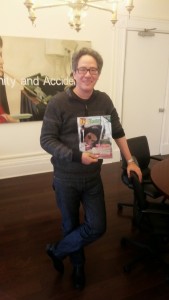
It’s like saying that, because computer hackers exist, we should ban computer programming. Computer programming as a technology is just a technology. What you want to know is what people are doing with computer programs. You don’t want them to write computer viruses. You don’t want them to write hacker codes that will break into your bank account. But that does mean you ban computer programming? No. You just want to make sure those types of activities are the ones you pay attention to. It is the same with GMO technology. It is the products that you monitor.
People think that classic (traditional or conventional) breeding is somehow better than GMO technology. My real sense is that in breeding there is a lot of uncertainty. In traditional breeding, one crosses strains that have not come into contact with each other and mixes hundreds and thousands of mutations. While with GMOs, breeders insert only a few genes that they know a lot about. I actually have stronger confidence in our ability to control GMOs than the products of classical breeding.
GMOs go through enormous regulatory testing but traditionally bred crops do not. I guarantee that we know much, much less about what we did with a traditionally bred crop than what we did with a GMO crop.
What makes GMOs so scary?
People fear most a certain risk that may not be known yet. But that’s true for everything. We can always think of a worst-case scenario. Certain GMO products have been used for a long time. The reality is, with so many GMO products in the market and available all over the world, nobody, not one person, can be shown to have died or have had a health problem because of a GMO. There have been no issues with GMOs. I don’t know what else we can do.
What is a worst-case scenario for GMOs such as Golden Rice?
I can’t even think of a worst-case scenario. We can talk about its efficiency or if there are better approaches. Maybe there is a risk that the carotene genes might cross into wild rice–so does that mean the wild rice might have carotene? I can’t see any substantial environmental impact. We eat carotene. It’s not like there’s a health risk. If we eat some fruits, we get carotene. I don’t see why that’s a problem. The science community is composed of people of high integrity, especially public-sector organizations such as IRRI. They are not going to consciously produce anything that, when brought to the field, is going to create problems.
________________
Mr. Santiaguel is associate editor of Rice Today.




